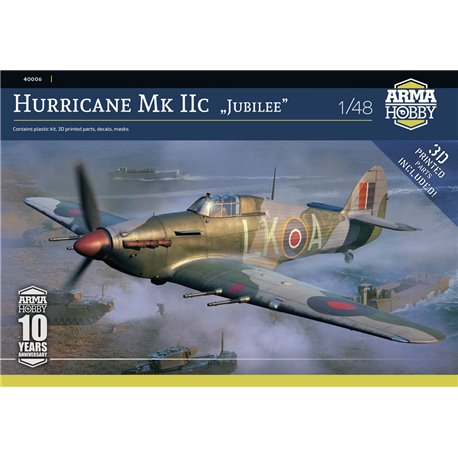More info
This is a kit with paintwork from Operation Jubilee - the Allied landing at Dieppe, complete with a full set of resin additions in 3D printing.
The kit includes:
- Hurricane IIC 1/48 plastic mouldings (moulds 2023)
- decals for 3 paint schemes from the "Jubilee" operation
- self-adhesive "kabuki" masks for painting the cabin and wheels
- 3D printed resin accessories: seat with straps, two types of exhaust pipes, two types of cannon.
Marking variants:
- Hurricane Mk.IIc BE500/LK-A. 87th RAF Squadron. Tangmere Airfield. Three combat flights in Operation Jubilee. Pilots: S/Ldr D.G. Smallwood and F/L A.H. Thom.
- Hurricane Mk.IIc Z3081/FT-V "Baron Dhanis". 43rd RAF Squadron. Tangmere Airfield. Three combat flights in Operation Jubilee. Pilot S/Ldr D.A.R.G. Le Roy du Vivier (Belgium).
- Hurricane Mk.IIC BD867/QO-Y, 3rd Squadron RAF, Hunsdon Airfield, Autumn 1941 The aircraft was shot down during Operation Jubilee, pilot Sgt. Stirling David Banks (RCAF) fell. The appearance and markings of the aircraft on 19 August 1942 are unknown.
The Hawker Hurricane is a British single-engine single-engine fighter with a metal structure with canvas elements from the Second World War. Acting on all fronts during the Second World War, the Hawker Hurricane earned the name of one of the best and most ubiquitous airplanes of that time, both as a fighter and an attack plane. Undoubtedly, however, the most significant card in the history of this machine was its contribution to the victory of the British in the Battle of Britain in 1940. The plane constructed by Sydney Camm at the request of the Ministry of Defense was supposed to become the main force of the British air fleet. For the first time, a prototype of an aircraft powered by a Rolls-Royce Merlin Mk.II engine took off on November 6, 1935, piloted by Georg Bulman. The tests were excellent and it was quickly decided to order 600 machines, the first of which entered service with the 111th squadron of the RAF in December 1937. When Great Britain declared war on Nazi Germany on September 3, 1939, the RAF had 19 ready-to-fight Hurricane squadrons, which started their military career with operations in France and Norway. During the course of the war, several versions of this very successful plane were created. The first mass-produced version was the Mk.I with the Merlin III engine. From 1940, the Mk.II versions with the new Merlin XX engine with a capacity of 1280 HP began to be delivered to the units. It was this version, as the first variant of Hurricane, that performed primarily assault and battlefield support tasks. Its best variant was the Hurricane Mk.IID, used by min. in the North Africa campaign in 1942. The third version is the Hurricane Mk.IV with the new Merlin 24/27 engine, 1620HP. It served as an assault machine armed with bombs, unguided missiles and Vickers S cannons until 1944. A sea variant (Sea Hurricane) was also produced, which served on aircraft carriers and on specially adapted merchant ships (Sea Hurricane Mk.IA). Technical data (Mk.IIC version): length: 9.84m, wingspan: 12.19m, height: 4m, maximum speed: 547km / h, rate of climb: 14.1m / s, maximum range: 965km, maximum ceiling 10,970m Armament: fixed - 4 20mm Hispano Mk.II cannons, sling - up to 460 kg of bombs.






